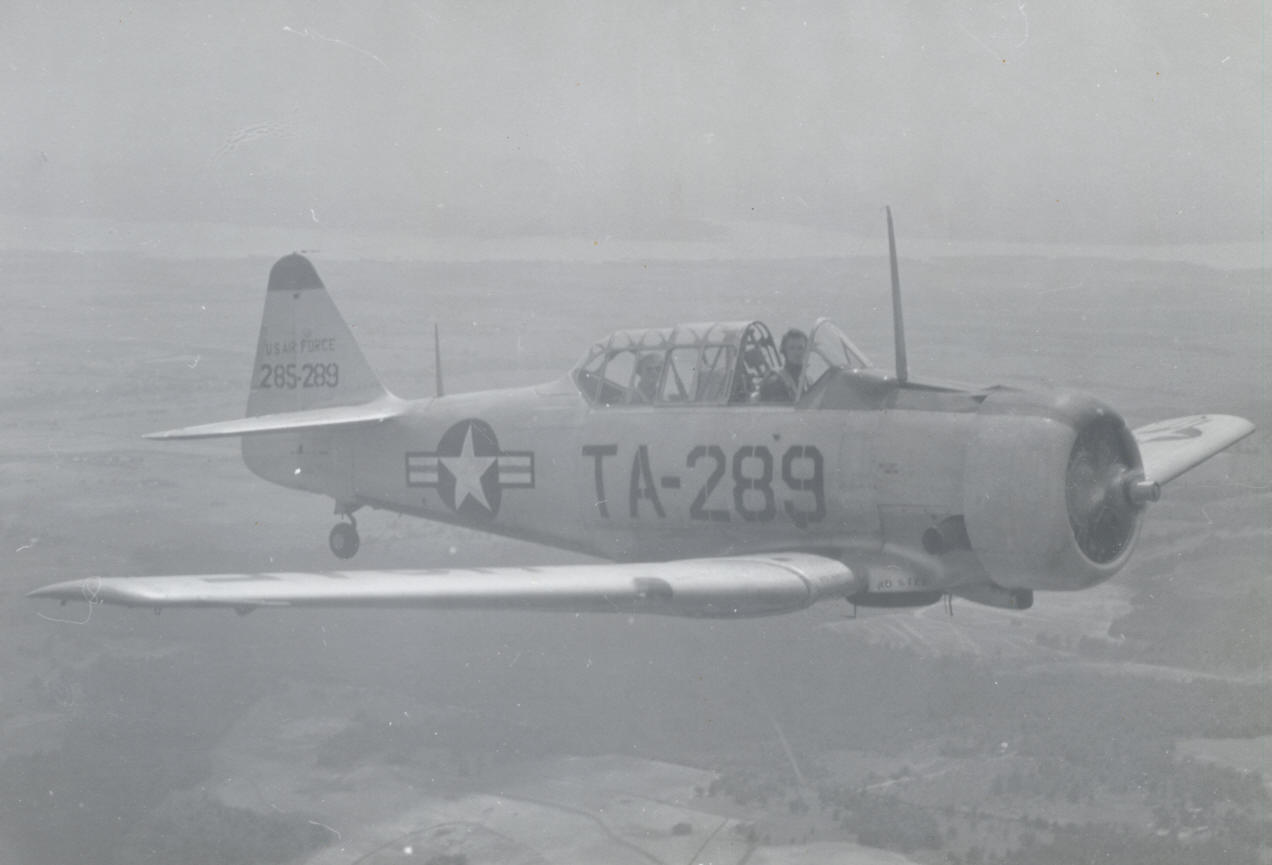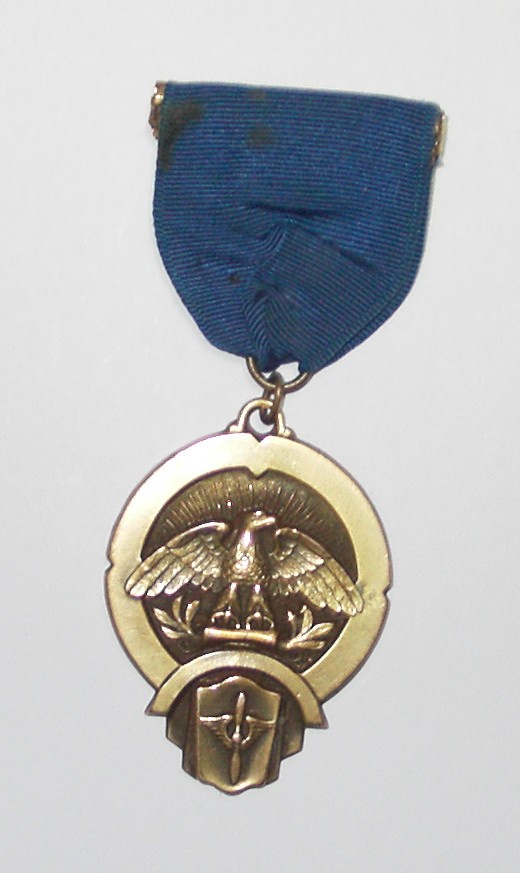Pilot Training with the T-6 and B-25
Air Force Days - Jun 23,2017
Air Force Pilot Training
Class of 50F
During the '50s the US Air Force was training a lot of pilots in a one-year program. There were lots of training bases and lots of classes at each base. The Class of 50F was the sixth class to graduate in 1950. For the first six months (called primary training) I was stationed at Perrin AFB, Sherman, Texas, which is about 50 miles north of Dallas, then finished up (basic training) at Reese AFB, Lubbock, Texas on October 28th.

Our primary trainer, the T-6 "Texan." This is the "good ol' T-6," used for primary pilot training. We were told, "If you can fly this, you can fly anything." Vicious stall characteristics. Prone to ground loops on landing. Can't see where you're going while taxiing. Also, 650 HP is a bit much for one's first airplane.
At our first briefing at the beginning of training, we were in rows of seats and told to look at those sitting on each side of us. "They will both be gone when you finish this course." And that's about the way it was. My first instructor had five students, and I was the only one who completed primary training. This was in the winter of 1950.

Just for melodrama, here is Miles with high hopes for pilot training - the dawn of a flying career.

This was my first instructor, Lt. Littlejohn (left) with one of the original five. He was not harsh or difficult - it was the airplane that was difficult. Early on, I nearly killed both of us while learning to land that thing.
The students were a mix of aviation cadets (my status) and recently graduated ROTC officers.
I soloed from a grass field at Gainesville, Texas. Later, in the spring, we went back there for some graded landings, and had the beautiful experience of landing in a field of tall waving flowers.

I'm with some of my friends and fellow students.

Above:: After each flight the pilot has to complete the "Form 1," which is the aircraft flight record. This includes total time, any "weather time" (IFR - instrument flight rules) or night time. Also recorded are any conditions needing maintenance. As student pilots, we were not allowed to fly solo IFR, but had to have an instructor with us. During this primary training, I got several hours of weather time.

Above: My friend, E.E. Brown who took most of the pictures. We called him E-Square Brown. Someone told me he was killed when we got to basic training.

Barracks antics. My roommate is seen shining his shoes for inspection next day.
You may wonder how I got into that position on the chair. I had to begin from the sitting position, then cross my legs and tuck them up close to my chest and press up to a handstand. Now in my early 90's, I can hardly imagine that!

More nonsense. That "club" is actually the rear cockpit control stick, which was removable.

Pensive. I don't remember why I chose to look so solemn.

I can't tell for sure, but I think the man flying formation is my second instructor. I had only two.

Another formation shot. On my first formation flight (with my instructor), we were lead plane for a formation takeoff with three planes. On the second flight the instructors forgot that I had never made a formation takeoff in wing position, and I was a solo wingman. With less weight, my plane became airborne first. I was afraid to reduce power, so I passed the leader -- somewhat embarrassing.

Here is a picture of our graduation party (1st half of training). Many of us were married. In the afternoon of this day, one of the students said, "Thank God this is the last time I'll have to fly with that Son of a Bitch!" Evidently they were arguing and fighting in the cockpit, which caused them to stall out in the landing traffic pattern and crash. The power-on stall characteristics of this plane are vicious.

After this primary training, I rode with one of my classmates who had a car to Lubbock, Texas and checked in at Reese AFB. The picture abve shows a B-25 with all the guns. Ours used in basic pilot training were stripped of all that.
After a few more hours of T-6 training, we began with the B-25. I had an excellent instructor, Lt. Olcott. I lost contact with him after graduation, but I clearly remember how thorough and challenging he was. He made me do things with that airplane that were more difficult than what was in the syllabus. For example:
The B-25 was inherently difficult to taxi because the nosewheel was not steerable and the brakes were "grabby." What that amounted to is that when trying to stop straight ahead, one main gear brake would very likely grab and stop while the other was still rolling. Students were forever getting the nosewheel "cocked," and it was not easy to recover (until you really knew how). The common saying was that by the time you learn to taxi that airplane, you're ready to graduate. When I would be starting out on an instrument flight lesson, he would have me put up the "hood" (so one can't see out) while still in the parking spot, then taxi out while under the hood. He would tell me to "make a standard rate turn to the right and roll out on heading 260" (between the two rows of aircraft). I would be given commands like that all the way to the takeoff position. The hooded instrument takeoff was routine for everyone.
Incidentally, the "hood" for the B-25 was orange plexiglass panels put up in the front and side windows, and the person to be hooded wore blue goggles. Very effective.
Another extracurricular thing he had me do was "real" instrument landings under the hood. It was to be a long time before this could be done electronically, and there was a minimum ceiling and visibility requirement for radar ground control approach (GCA). The way he did this was to pretend to be the GCA operator, and talk me down all the way to the runway. When we got about 100 feet above ground he would tell me to reduce the rate of descent to 300 feet per minute and just fly it onto the runway. We would land with a slight bump, but it was quite safe. We did not have any flight simulators.
Every student got a weekend cross-country flight shortly before graduation. We were going to go to Tampa, Florida, and Lt Olcott had me and one other student prepare a maximum cruise control flight (using the charts in the pilot's handbook) so as to go non-stop all the way to MacDill AFB. It was to be about 7.5 hours. On the day of our flight a hurricane was approaching Florida, but it was doubtful whether it would affect us. Finally, about 10:00 pm, we were cleared to go. We flew all night. The runway at MacDill was so long and wide, that (in the morning twilight) I thought at first it was a farm! We had about four or five hours of sleep and were then called to evacuate the field.

In the summer prior to graduation we had an intramural track meet in which I did some pole vaulting. As far as I can remember, there weren't any coaches, and no one trained for it, but we had a good time. There was very little activity of this sort, so I ended up being elected by my classmates to receive the "outstanding athlete" award.

There's an amazing story to go with this. I didn't know anything about getting a medal. Then, about the year 2005 (more than half a century after graduation), I received a message from a lady in Arizona who said she had been looking for me so as to give me this medal . She said she looked me up on the Internet.
She wrote that she had bought a chest of drawers at some yard sale about 20 years ago, and recently needed to move this piece of furniture. In the course of moving it, she discovered a "secret" space behind one of the drawers, where she found the medal.
I could not have put the medal into any such place, because I was living in an Air Force barracks. About six weeks prior to graduation I got a cheap apartment for my wife, Bernice. It certainly would not have had any such fancy furniture, and why would I hide the medal? Anyway, now I have it, and it's a nice memory.
We did not have a graduation party, but we did put on an "air show" of sorts. We had about 15 or 20 B-25s in a bomber formation, got into echelon formation as we approached the field, and "peeled off" for landing.